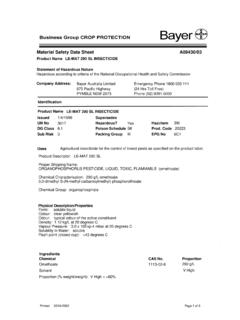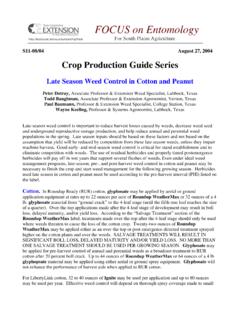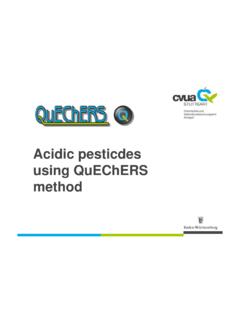Transcription of Product Name: Farmoz MCPA 500 Selective Herbicide ... - DKT
1 Product Name: Farmoz MCPA 500 Selective Herbicide Page: 1 of 5 This revision issued: November, 2003 MATERIAL SAFETY DATA SHEET Issued by: Farmoz Pty Ltd Phone: (02)9431 7800 Section 1 - Identification of Chemical Product and Company Statement of Hazardous Nature This Product is classified as: Hazardous according to the criteria of NOHSC Australia. Not a Dangerous Good according to the Australian Dangerous Goods (ADG) Code. Farmoz Pty Ltd, Suite 1, Level 4, Building B 207 Pacific Highway, St Leonards, NSW 2068 ACN 050 328 973 Telephone (02)9431 7800 (24 hours)Fax (02)9431 7700 Substance: MCPA is an aryloxyalkanoic acid derivative. Trade Name: Farmoz MCPA 500 Selective Herbicide Product Use: Agricultural Herbicide for use as described on the Product label.
2 Creation Date: July, 2002 Revision Date: November, 2003 Section 2 Composition/Information on Ingredients IIInnngggrrreeedddiiieeennntttsss CCCAAASSS NNNooo CCCooonnnccc,,,%%% TTTWWWAAA (((mmmggg///mmm333))) SSSTTTEEELLL (((mmmggg///mmm333))) MCPA 94-74-6 50 not set not set Other non hazardous ingredients secret to 100 not set not set This is a commercial Product whose exact ratio of components may vary slightly. Minor quantities of other non hazardous ingredients are also possible. The TWA exposure value is the average airborne concentration of a particular substance when calculated over a normal 8 hour working day for a 5 day working week. The STEL (Short Term Exposure Limit) is an exposure value that should not be exceeded for more than 15 minutes and should not be repeated for more than 4 times per day.
3 There should be at least 60 minutes between successive exposures at the STEL. The term "peak "is used when the TWA limit, because of the rapid action of the substance, should never be exceeded, even briefly. Section 3 - Hazards Identification Risk Phrases: R22, R38, R41. Harmful if swallowed. Irritating to skin. Risk of serious damage to eyes. Safety Phrases: S20, S36, S24/25. When using, do not eat or drink. Wear suitable protective clothing. Avoid contact with skin and eyes. SUSDP Classification: S6 ADG Classification: None allocated. Not a Dangerous Good. UN Number: None allocated EEEmmmeeerrrgggeeennncccyyy OOOvvveeerrrvvviiieeewww Physical Description & colour: Clear brown liquid. Odour: ammoniacal odour. Major Health Hazards: MCPA acid is harmful via ingestion, with reported oral LD50 values for the technical Product in rats ranging from 700 mg/kg to 1160 mg/kg and ranging in mice from 550 to 800 mg/kg.
4 It is harmful via the dermal route as well, with reported dermal LD50 values ranging from greater than 1000 mg/kg in rats to greater than 4000 mg/kg in rabbits. Symptoms in humans from very high acute exposure could include slurred speech, twitching, jerking and spasms, drooling, low blood pressure, and unconsciousness. irritating to eyes and skin, harmful if swallowed, PPPooottteeennntttiiiaaalll HHHeeeaaalllttthhh EEEffffffeeeccctttsss See section 11 for Chronic exposure studies. Inhalation Short term exposure: Available data indicates that this Product is not harmful. In addition, this Product is unlikely to cause any discomfort or irritation. Skin Contact: Short term exposure: Available data indicates that this Product is not harmful.
5 It should present no hazards in normal use. However, this Product is a skin irritant. Symptoms may include itchiness and reddening of contacted skin. Other symptoms may also become evident, but all should disappear once exposure has ceased. Product Name: Farmoz MCPA 500 Selective Herbicide Page: 2 of 5 This revision issued: November, 2003 MATERIAL SAFETY DATA SHEET Issued by: Farmoz Pty Ltd Phone: (02)9431 7800 Eye Contact: Short term exposure: Available data shows that this Product is not harmful. However, this Product is a severe eye irritant. Symptoms may include stinging and reddening of eyes and watering which may become copious. Other symptoms such as swelling of eyelids and blurred vision may also become evident. If exposure is brief, symptoms should disappear once exposure has ceased.
6 However, lengthy exposure or delayed treatment is likely to cause permanent damage. Ingestion: Short term exposure: This Product is harmful if swallowed. See symptoms above. Carcinogen Status: NOHSC: No significant ingredient is classified as carcinogenic by NOHSC. NTP: No significant ingredient is classified as carcinogenic by NTP. IARC: No significant ingredient is classified as carcinogenic by IARC. Section 4 - First Aid Measures General Information: You should call The Poisons Information Centre if you feel that you may have been poisoned, burned or irritated by this Product . The number is 13 1126 from anywhere in Australia and is available at all times. Have this MSDS with you when you call. Inhalation: First aid is not generally required.
7 If in doubt, contact a Poisons Information Centre or a doctor. Skin Contact: Quickly and gently, blot or brush away excess chemical. Wash gently and thoroughly with water (use non-abrasive soap if necessary) for 20 minutes or until chemical is removed. Under running water, remove contaminated clothing, shoes and leather goods ( watchbands and belts). If irritation persists, repeat flushing and obtain medical advice. Completely decontaminate clothing, shoes and leather goods before reuse or discard. Eye Contact: Quickly and gently blot or brush away Product . Immediately flush the contaminated eye(s) with lukewarm, gently flowing water for 20 minutes or until the Product is removed, while holding the eyelid(s) open. Take care not to rinse contaminated water into the unaffected eye or onto the face.
8 Ingestion: If swallowed, do NOT induce vomiting. Wash mouth with water and contact a Poisons Information Centre, or call a doctor. Section 5 Fire Fighting Measures Fire and Explosion Hazards: There is no risk of an explosion from this Product under normal circumstances if it is involved in a fire. Fire decomposition products from this Product may be toxic if inhaled. Take appropriate protective measures. This Product is likely to decompose only after heating to dryness, followed by further strong heating. Extinguishing Media: Not Combustible. Use extinguishing media suited to burning materials. Fire Fighting: Flash point: Will not burn until water component is driven off. Upper Flammability Limit: Does not burn.
9 Lower Flammability Limit: Does not burn. Autoignition temperature: Does not burn. Flammability Class: Does not burn. Section 6 Accidental Release Measures Accidental release: In the event of a major spill, prevent spillage from entering drains or water courses. Wear full protective chemically resistant clothing including face mask, face shield, gauntlets and self contained breathing apparatus. See above under Personal Protection regarding Australian Standards relating to personal protective equipment. Suitable materials for protective clothing include rubber, PVC. Stop leak if safe to do so, and contain spill. Absorb onto sand, vermiculite or other suitable absorbent material.
10 If spill is too large or if absorbent material is not available, try to create a dike to stop material spreading or going into drains or waterways. Avoid using sawdust or other combustible material. Sweep up and shovel or collect recoverable Product into labelled containers for recycling or salvage, and dispose of promptly. After spills, wash area preventing runoff from entering drains. If a significant quantity of material enters drains, advise emergency services. Full details regarding disposal of used containers, spillage and unused material may be found on the label. If there is any conflict between this MSDS and the label, instructions on the label prevail. Ensure legality of disposal by consulting regulations prior to disposal.












